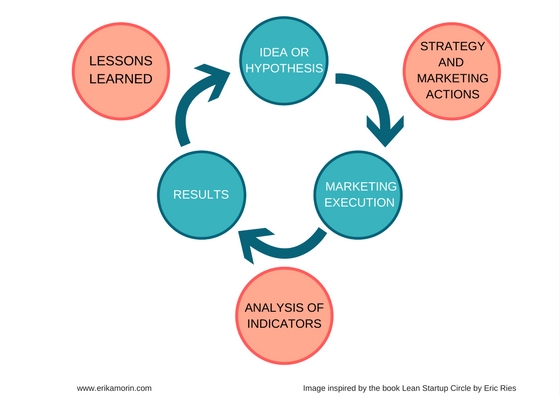Lean Marketing is also inspired by the Agility and Effectuation theories. It is a step-by-step process of simplifying the problem and moving quickly to action. Below, I explain how to start with your first iteration of Lean Marketing:

1. Plan your experimentation
To conceptualize your first iteration and enter on the experimentation loop you must start by answering these questions:
- What is the problem (simplified) that your product or service solves?
- What is your target?
- What is the assumption that you are validating?
- What are your key performance indicators (KPI)?
2. Establish a strategy to reach your target
Think about where your target is and how you want to reach it. Are your users on the Internet? Do they use websites? How does your target search on Google? Are your clients using social networks? Are they more addicted to e-mail or do they prefer direct contact? Do not forget to think about the behaviour of your target users. In terms of content, do they read online, or do they prefer to watch videos?
Regarding the communication, try to be practical and do not try to produce perfect multimedia contents. Take small risks! You can always improve in the next iteration.
3. Mesure your actions
As soon as the test communication is established, you must choose the performance indicators. In order to do this, identify measurable behaviours of your target that can help you validate (or invalidate) your hypothesis. For example, the number of interactions on a publication, the commitment rate on a specific activity, the number of users subscribed to your service, the number of emails picked up in your landing page, and so on.
4. Learn from your mistakes and pivot
This is the final and most important phase of your iteration. After analyzing the results, you will be able to understand your indicators to decide if you go further with your assumption (including improvements) or if you change completely (pivot to another idea). For example, if you are testing a Facebook promotion for launching a product and your campaign is not having enough likes, ask yourself: Is it necessary to analyze value proposition? Was the target properly chosen? Is the message engaging? In this case, you have at least three more cycles to test.
In summary, Lean Marketing offers marketers an open mindset to forget rigid and sequential marketing strategies (waterfall) and adopt an iterative and validated business process (Lean). Do not wait anymore and start to do your little tests! Comment on your experiences below, I would love to share with you!

